Abstract
In this study, the annual electricity consumption of nine real houses from different cities in Türkiye was recorded on a monthly basis. The feasibility of meeting the electrical energy needs of houses with hydrogen and supplying the energy required for hydrogen production using solar panels is examined. The annual electricity consumption of the houses was normalized based on house size. The solar panel area for hydrogen production needed for these houses was defined. Additionally, it was calculated that the average volumetric amount of hydrogen produced per hour during peak sun hours in the investigated cities was 1 m3/h. This approach reduced the solar panel area for hydrogen production by a factor of 1.7.
1. Introduction
Interest in the household use of clean and sustainable energy sources is increasing remarkably. This interest is expected to grow with population growth and urbanization. Considering the aim of carbon footprint reduction, interest in reducing the use of fossil fuel resources, adopting environmentalist approaches, and the transition from fossil fuel sources to renewable sources is driven by necessity. This interest also contributes to global sustainability and clean energy demand [1,2,3,4,5]. In [1], Wenli Li et al. investigated the relationship between clean energy and household members’ health using rural residential cooking data and determined its effects on sustainable development. Chunyue Bai et al. [2] investigated the clean energy transition and energy poverty alleviation relationship using household data and found that energy poverty is an obstacle to the sustainable development of developing countries.
Rufei Ma et al. [3] investigated the impact of environmental regulations on energy poverty at the household level, especially for those using non-clean energy. In [4], Joseph Elasu et al. investigated the drivers, theories, and methodologies of the energy transition at the household level. Abdulai Adams et al. [5] investigated the supply of clean, efficient, and sustainable cooking fuel for households without access to sustainable and clean cooking fuels. As seen in [1,2,3,4,5], clean and sustainable energy will contribute to solving the household energy problem. At this point, hydrogen has emerged as a remarkable source that is used in transportation and industry and can also be a good alternative for household use [6,7,8,9]. Marco A. Hernández-Nochebuena et al. [6] investigated time-variant restrictions, such as power load and solar energy, on the hydrogen production of an off-the-grid energy system that provides energy to a household and a vehicle. In [7], Orana Sandri et al. investigated the relationship between vulnerability and gas usage in individual households, specifically concerning hydrogen. Gamze Soyturk et al. [8] investigated a management strategy to meet the electricity needs of a house with a hybrid system based on solar and hydrogen energy, focusing on minimizing the number and capacity of the main system components. In [9], Sergio J. Navas et al. studied the use of photovoltaic energy and thermal solar energy on a residential scale. Studies have been performed in China [1,2,3], Ghana [5], Mexico [6], Australia [7], Türkiye [8], and Spain [9].
The widespread use of hydrogen draws attention to hydrogen production. Traditional methods, such as steam methane reforming and coal gasification, are not environmentally friendly; hydrogen production through electrolysis using solar and wind energy is the most environmentally friendly solution [10,11,12,13,14,15,16,17,18]. Zihan Zhen et al. [10] consider hydrogen as a key technology to achieve China’s goal of carbon neutrality. The authors used different methods and found that the production costs of green hydrogen will become more economical than those of gray and blue hydrogen. In [11], Xiaojiang Hou et al. investigated the effect of alloys on the rate of hydrolytic hydrogen production by considering the temperature in the methods used for electrocatalytic hydrogen production, photocatalytic hydrogen production, biological hydrogen production, and hydrolytic hydrogen production. Tianqing Zheng et al. [12] studied the increasing hydrogen production capabilities of a self-thermal methanol steam reforming microreactor using catalyst support. Guangfu Liao et al. [13] investigated hydrogen production from lignocellulose using photoreforming technology. Hongrui Zhu et al. [14] investigated the photocatalytic conversion of solar energy into hydrogen. In [15], Chunxue Li et al. proposed a simple strategy for significantly improving PHE (photocatalytic hydrogen evolution) efficiency. Lúcia Bollini Braga Maciel et al. [16] conducted an environmental comparison using renewable electricity generated by solar photovoltaic (PV), wind energy, and hydroelectric systems with an electrolytic process for green hydrogen production in terms of global warming potential and greenhouse gases. In [17], Rok Lacko et al. analyzed the optimal design of a solar–wind–hydrogen system by considering the geographical location, availability of energy sources, actual load dynamics, and components’ technical and economical characteristics. In [18], Hossam A. Gabbra et al. examined the efficacy of replacing fossil fuels with renewable hybrid systems in buildings. The potential of hybrid renewable energy systems, emphasizing their transformative role in addressing the energy requirements of buildings, was investigated in their study. The important functions of hybrid renewable energy systems in promoting both environmental and socio-economic sustainability were also highlighted in this study. By integrating diverse renewable sources, these systems offer a robust and adaptable approach to energy generation, effectively mitigating reliance on traditional fossil fuels. Ultimately, it was demonstrated that hybrid renewable energy systems provide a compelling and viable pathway toward achieving sustainable energy solutions for buildings, offering a balance between ecological responsibility and societal well-being [18].
Hydrogen can be used for electricity generation, blending with natural gas, and energy storage [19,20,21,22]. Yaodong Wang et al. [19] investigated the performance, efficiency, and emission characteristics of a household-scale trigeneration system based on a diesel engine generator fueled with hydrogen compared to single-generation and cogeneration systems. In [20], Merve Ozturk et al. investigated a geothermal-based energy system for hydrogen production and blended hydrogen with natural gas for use in household devices, such as gas stoves and combi boilers. In their study, it was stated that blending up to 20% hydrogen into natural gas reduces CO2, steam, and heat release while increasing the oxygen output in the combustion process [20]. Merve Oztürk et al. [21] proposed an integrated fuel processing system for a rapid transition to a hydrogen economy by using hydrogen sulfide and natural gas resources found in the Black Sea. This system uses offshore wind and offshore photovoltaic power plants to provide the electricity required for hydrogen production. This approach aims to extend natural gas reserves, reduce carbon dioxide emissions, and decrease annual natural gas costs. The analysis in the study shows improvements in combustion energy and exergy efficiencies, with overall system efficiencies of 64.8% and 61.1%, respectively. The proposed system offers a promising avenue for practical applications of hydrogen–natural gas blending [21]. Johannes Hyvönen et al. [22] investigated the cost-effectiveness of using different energy storage technologies, such as lithium-ion batteries, hydrogen, and thermal energy, in detached houses to improve the utilization of solar photovoltaic (PV) electricity generation. The study aimed to determine whether investing in energy storage technologies is financially viable for homeowners in southern Finland who want to maximize the benefits of their solar PV systems. The study highlights the impact of electricity market prices and discount rates on profitability and concludes that achieving EU renewable energy targets in residential buildings necessitates changes in technology costs, electricity prices, or policy implementation. Furthermore, the study suggests exploring community-scale energy storage and considering other building types and geographical locations for future research [22]. In [23], Takaaki Kato et al. examined the perceptions of residents with photovoltaic panels in their homes toward hydrogen electricity storage systems, how these perceptions compare to batteries, the willingness to pay for improved hydrogen storage features, and how the presentation of the greenhouse gas reduction price affects the answers. This study surveyed 1000 Japanese residential PV users to understand their preferences for household hydrogen electricity storage compared to batteries. The results revealed that while batteries were perceived as safer and potentially cheaper, hydrogen storage was favored for its environmental impact and blackout resilience. The timing of consumer adoption of new appliances significantly influenced storage preferences, with early adopters demonstrating clearer preferences and greater knowledge of hydrogen storage [23]. In [24], Andrey Afanasiev et al. investigated citizen engagement with a hydrogen valley in Cyprus. The study reveals a strong public case for supporting the green energy transition in Cyprus, with around 80% of the participants indicating a potential willingness to support a hydrogen valley in Cyprus. The study advocates for integrating technological deployment with dynamic citizen involvement to achieve carbon neutrality and calls for further country-specific research on citizen engagement in hydrogen technology to support Europe’s 2050 carbon neutrality goals [24].
The photovoltaic–hydrogen system is suitable for household hydrogen use, especially with rooftop applications [25,26,27,28,29,30,31,32,33,34]. In [25], Muhammad Burhan et al. developed and tested a cost-effective and compact concentrated photovoltaic (CPV) system designed for rooftop applications, with a focus on its integration into a CPV-hydrogen production system. The CPV system is integrated with electrolyzers to produce hydrogen as a sustainable energy storage medium and carrier. The system includes a novel design configuration, including a master–slave tracking system and a low-cost, high-accuracy solar feedback sensor, to reduce the overall cost and hardware requirements. The proposed system emphasizes the importance of daily average and long-term solar-to-hydrogen (STH) efficiency as performance indicators and achieves 15% long-term STH efficiency, demonstrating the viability of this design [25]. In [26], Muhammad Burhan et al. investigated a cost-effective, high-accuracy compact CPV-hydrogen system designed for rooftop applications, particularly in tropical climates. Stable rooftop operation and reliable tracking performance are demonstrated using commercial sensors. To make high-efficiency CPV and hydrogen production technology more accessible to consumers, the study promotes better solar energy utilization [26]. In [27], Mostafa Rezaei et al. investigated the economic and environmental viability of implementing rooftop solar power systems for domestic use in Yazd, Iran, specifically focusing on electricity generation and potential hydrogen production. It is demonstrated that providing surplus electricity, generating income by selling excess electricity to the grid, and significantly reducing CO2 emissions are possible. The authors uncovered both economic and environmental benefits, with solar-based hydrogen needing more support to become a reality [27]. In [28], Vu Minh Phap et al. investigated the feasibility and potential of using rooftop solar power systems coupled with fuel cells to produce hydrogen in industrial plants across different provinces in Vietnam, based on varying solar energy potentials. In the study, a comparison of hydrogen production and fuel cell output in provinces with differing solar energy levels is performed, demonstrating the impact of solar potential on system performance [28]. In [29], Seyed Ehsan Hosseini et al. investigated the viability of a household energy system that uses hydrogen as an energy storage medium, where solar energy collected during the day is used to produce hydrogen, which is then used to generate electricity at night. Specifically, it is highlighted that the integration of a CPVT (concentrated photovoltaic thermal)-ORC (organic Rankine cycle) system with an electrolyzer and fuel cell offers the benefits of increased hydrogen production [29]. In [30], Mahsa Daraei et al. investigated the feasibility and optimization of integrating hydrogen storage with combined heat and power plants and rooftop photovoltaic systems in a central Swedish energy system, focusing on improving flexibility, reducing costs, and decreasing environmental impact. The study contributes to enhancing the flexibility of the energy system, reducing reliance on external power imports, potentially lowering carbon emissions, optimizing storage capacity for cost-effectiveness, utilizing waste heat for district heating, and producing renewable-based hydrogen for other applications [30]. In [31], Jonte Dancker et al. aimed to evaluate the decarbonization potential of heat pumps (HPs), rooftop photovoltaic (PV) systems, and hydrogen mixing by investigating air conditioning on a typical US heat network in a cold and humid climate. Their analysis revealed that the network can accommodate significant HP and PV penetration without major voltage or congestion issues. However, although it helps to reduce CO2 emissions, it is economically impractical due to the high production cost and minimal impact on network outages. Although HPs and PV systems are promising carbon-reducing technologies, the study authors find that hydrogen blending may not be a viable solution in this context. It also provides an algorithmic framework for detailed examination of various delivery networks and higher HP penetration scenarios, empowering the expansion of improvements to accelerate net-zero targets [31]. In [32], Masood Ul Hassan et al. compared the performance of 13.5 kWh hydrogen and Li-Ion batteries in rooftop solar PV systems under time-of-use and solar feed-in tariffs, using operational data from a 4.5 kWp system over three years. The results of the study indicate that Li-Ion batteries outperform hydrogen batteries in capacity utilization, grid impact, payback periods, and financial returns due to their higher roundtrip efficiency. Hydrogen batteries consume more energy and require significant water resources, posing challenges in water-scarce regions. Weather extremes, such as La-Niña and El-Niño, also influence battery selection, with hydrogen potentially favored during periods of excess rainfall and Li-Ion favored during droughts. While Li-Ion offers better financial profits under normal conditions, hydrogen provides longer battery life. The optimal battery choice depends on water availability, weather, and the prioritization of financial gain versus battery longevity [32]. In [33], Antonia Cevallos-Escandón et al. investigated the potential of utilizing Cuenca’s solar energy surplus, generated from rooftop photovoltaic installations, to transition the city’s public transportation system to hydrogen fuel. The analysis demonstrates that the solar energy surplus could fully power the city’s bus fleet, significantly reducing CO2 emissions and diesel consumption. Hydrogen, produced from the surplus, offers a viable alternative to fossil fuels, potentially eliminating 60% of the city’s greenhouse gas emissions. However, the study acknowledges challenges such as water requirements for hydrogen production and storage limitations, emphasizing the need for further research and political support to facilitate a successful transition to clean hydrogen-based transportation [33]. In [34], Seyfi Şevik investigated the feasibility and potential of integrating rooftop photovoltaic (PV) systems, including hybrid configurations with existing trigeneration plants, and solar hydrogen production on a university campus in Türkiye. In the study, the energy output, greenhouse gas emissions, and economic viability of various scenarios, including grid-connected PV systems, PV systems with canopies, and hydrogen production via different methods, were analyzed through detailed simulations. The results of the study demonstrated the technical and economic potential of PV integration, with significant reductions in carbon emissions and viable levelized costs of electricity. The study further explored hydrogen production, comparing different technologies and energy sources, and concluded that while PV-based hydrogen offers long-term advantages, trigeneration-based hydrogen provides a lower initial cost. The research highlights the effectiveness of simulation tools for PV system design and emphasizes the importance of considering economic and environmental factors for sustainable energy solutions on university campuses [34].
This study aims to investigate solar-powered hydrogen production using commercially available devices in residential settings in Türkiye. The annual electricity consumption data of nine cities in seven provinces of Türkiye is used. The consumption values were normalized and the required solar panel area was defined for residential applications using two different approximations. An average value for hydrogen produced in one hour is defined. It was found that solar–hydrogen production and household usage of hydrogen are feasible for different cities in Türkiye.
2. Materials and Methods
2.1. Study Area and Data Collection
This study examines electricity consumption data from nine cities across seven provinces in Türkiye. Table 1 presents the investigated cities and corresponding house sizes.

Table 1.
Investigated cities and house sizes.
Electricity consumption was analyzed to determine whether household energy demand could be met using hydrogen produced via solar-powered electrolysis. Temperature and solar radiation data were sourced from the Turkish State Meteorological Service and the Solar Energy Potential Atlas (GEPA) [35,36].
Based on Turkish State Meteorological Service data [35], the annual average temperature, the annual average maximum temperature, the annual average minimum temperature, the month with the highest temperature, and the month with the lowest temperature values of the investigated cities are presented in Table 2.

Table 2.
Temperature information of the cities.
2.2. Normalization Methods
Two methods were employed to determine the solar panel area required for hydrogen production:
- House Size Normalization: Monthly electricity consumption was assumed proportional to house size, standardizing all households to a 100 m² benchmark.
- Hydrogen Production Normalization: The hourly hydrogen production rate was calculated for each house and normalized to an average value.
The schematic representation is given in Figure 1.
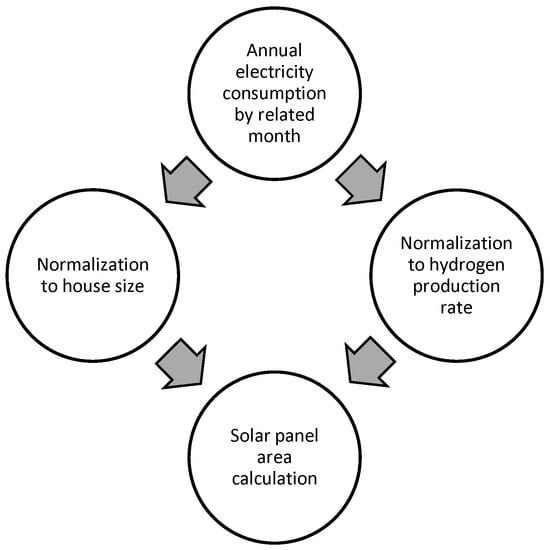
Figure 1.
Schematic representation of the methods.
The methods mentioned above are based on the volumetric production rate of hydrogen supplied by commercial devices. A 400 W monocrystalline solar panel with a panel area of 2 m2 and an efficiency of 20% was selected. The system requires two AC/DC converters: one for the PEM electrolyzer and another for the household system. The power of the inverter used for the electrolyzer is 5 kW (93% efficiency) and the power of the inverter used for the house is 6 kW (97% efficiency). The power of the fuel cell was selected as 6 kW and efficiency greater than 50 to feed the inverter selected for the house. An AC feed PEM electrolyzer was selected that has a 1 m3/h hydrogen production rate, hydrogen purity → 99.999%, and power → 10 kW. The hydrogen tubes have an 8.35 m3 capacity at 200 bar. A schematic representation of the system is presented in Figure 2.
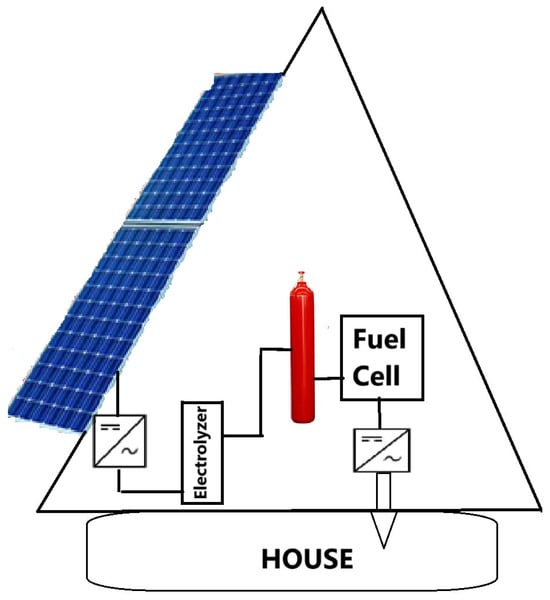
Figure 2.
Schematic representation of the rooftop application.
The calculations presented below are also used in our earlier studies [37,38].
Equation (1) presents the required amount of hydrogen for daily electricity demand.
where Cd is the daily electricity consumption (kWh) and 0.36 is the ratio of 1 kg H2 volume at room temperature (12 m3) to the energy content of 1 kg H2 (33.33 kWh). The unit of 0.36 is m3/kWh. ƞsys is the system efficiency and stands for the multiplication of the fuel cell and AC/DC converter efficiency.
To determine the amount of hydrogen to be produced in 1 h, calculations were performed using Equation (2).
where the amount of hydrogen to be produced in 1 h is symbolized by PH2, the required hydrogen is symbolized by RH2, and the peak sun hours of the city are symbolized by PSH. For determining the amount of hydrogen to be produced in 1 h, it is assumed that hydrogen production only takes place during peak sun hours.
3. Results
3.1. Normalized Electricity Consumption
Table 3 presents the highest recorded electricity consumption for each city after normalization.

Table 3.
Normalized electricity consumption by city.
To reach the consumption for 100 m2 standard houses, the normalized value is magnified by 100. The electricity demand for the house will be met by the hydrogen fuel cells and the energy for hydrogen production will be provided by solar panels. Calculations are based on solar energy production during peak sun hours. Peak sun hours refer to the average daily duration of sunlight received in the investigated cities. The values of the peak sun hours for the investigated cities are taken from the Republic of Türkiye Ministry of Energy and Natural Resources’ Solar Energy Potential Atlas (GEPA) [36] seen in Figure 3. The solar panel size required for hydrogen production was calculated for 100 m2 houses for all provinces included in the study. In Figure 4, the PV energy output for 1 kW of structural power is the amount of energy produced for 1 kW of installed power. The power data to be used to meet the electrical energy required for hydrogen production from solar panels were obtained from the European Commission Photovoltaic Geographical Information System [39] and are shown in Figure 4.
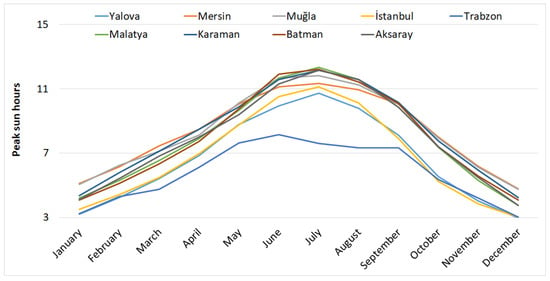
Figure 3.
Peak sun hours of the cities investigated in this study.
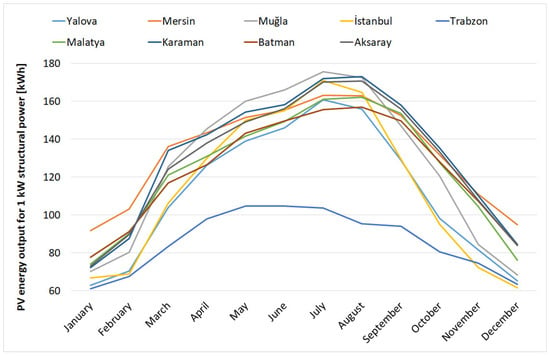
Figure 4.
The amount of energy produced for 1 kW of installed power.
As an example, the monthly electrical energy consumptions of the house in Trabzon are presented after normalization in Figure 5. The real consumption is 1.3 times higher according to the value in Table 3.
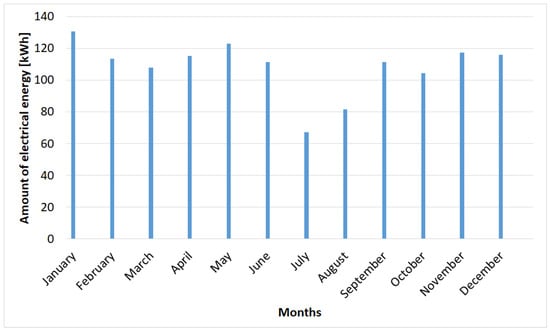
Figure 5.
The amount of energy used per house after normalization in Trabzon.
Daily hydrogen demand is the amount of hydrogen that will be used to produce electrical energy to meet the daily electrical energy needs of houses and is presented in Figure 6.
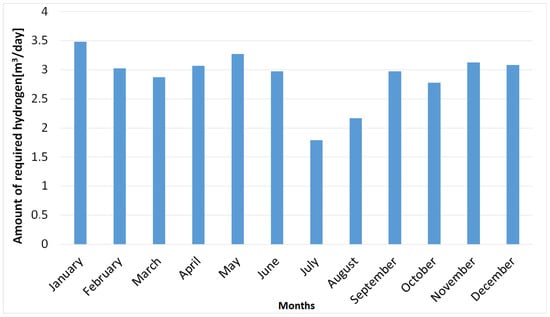
Figure 6.
The daily hydrogen demand in Trabzon per month.
3.2. Solar Panel Area for Hydrogen Production
The required solar panel area was calculated based on peak sun hours, as shown in Figure 7.
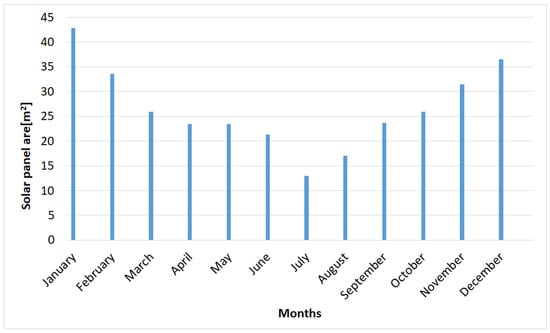
Figure 7.
Solar panel area required for hydrogen production in Trabzon.
The solar panel area to provide the energy required for hydrogen production was calculated each month and is presented in Figure 7 for the city of Trabzon.
In Trabzon, the highest required solar panel area was approximately 43 m² in January (Figure 7). Similar calculations were performed for other cities, yielding maximum values as presented in Figure 8.
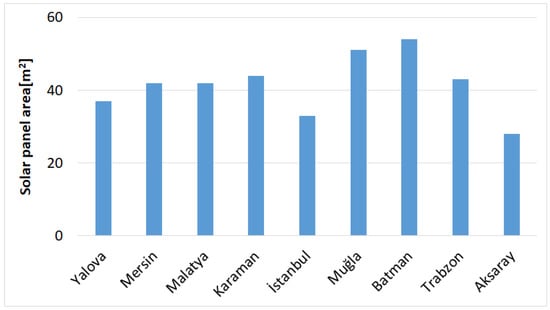
Figure 8.
Maximum solar panel area requirement across the cities.
The other method is based on the amount of hydrogen produced per hour. The maximum amount of hydrogen that should be produced per hour and in which month it should be produced was calculated. The results are presented in Table 4.

Table 4.
Amount of hydrogen produced per hour.
The values in Table 4 are normalized to the size of the houses and the normalized values are presented in Table 5. The values in Table 5 are illustrated in Figure 9 on the map of Türkiye.

Table 5.
Amount of hydrogen produced per hour after normalization.
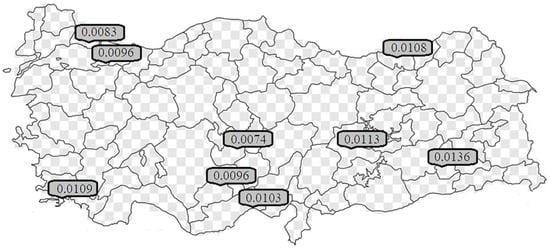
Figure 9.
Normalized hydrogen required per hour at related cities on the map.
When the values in Table 4 and Figure 9 were examined and when the consumption of the houses in the different regions of Türkiye was normalized according to the size of the houses, the hydrogen amount values that should be produced in an hour were close to one another. The average of the normalized values is . Here, m3/h is the amount of hydrogen that needs to be produced and A is the size of the house. Based on the average value, the solar panel area to provide the energy required for hydrogen production was calculated over 100 m2 houses for all provinces included in the study. The results are presented in Figure 10.
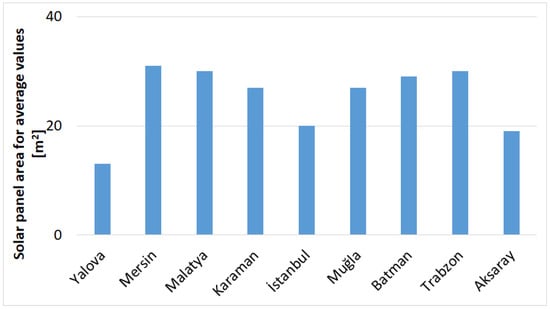
Figure 10.
Solar panel area for required energy for hydrogen production for the normalized hydrogen amount produced per hour.
The solar panel area values in Figure 10 are the maximum values for the cities. These values are required for the conditions in months that are presented in Table 6. Comparing Table 4 and Table 6, the maximum hydrogen production rate and the maximum solar panel area need to occur in different months.

Table 6.
Maximum solar panel area needs.
4. Discussion
In this study, the annual electricity consumption of nine real houses from seven provinces and different cities in Türkiye was used to investigate whether electricity consumption can be met by hydrogen produced by using solar panels as the energy source for hydrogen production. Two normalization methods were used, one for house size and the other for hydrogen to be produced per hour. For all cities, the need for solar panel area by month was calculated and the largest values were taken. The average amount of hydrogen to be produced per hour was determined to be 1 m³/h. Using this value reduced the solar panel area by 1.7 times, according to size normalization. These findings suggest that solar–hydrogen systems are viable solutions for all provinces in Türkiye.
In this study, the minimum solar panel area was considered and the system was optimized using commercial devices. The study can be extended using different optimization methods with increased amounts of data from all provinces in Türkiye.
Apart from data-based reviews, different types of solar panels, such as monocrystalline, polycrystalline, and PERC (passivated emitter and rear contact) and thin-film panels, and different types of electrolyzers, such as alkaline, PEMs (proton exchange membranes), and solid oxide electrolysis, can be considered in calculations. The fuel cell stack types that use hydrogen as an anode gas, such as AFCs (alkaline fuel cells), PEMFCs (proton exchange membrane fuel cells), and PAFCs (phosphoric acid fuel cells), can be considered in optimization studies. Moreover, hydrogen production techniques, such as thermal, biological, and thermochemical, and electrolytic and photolytic processes can be considered for optimization. The average value of the hydrogen to be produced per hour can be extracted by considering different storage techniques.
A cost analysis was not included in this study; however, preliminary estimates suggest that the payback period for solar–hydrogen systems exceeds 20 years based on household electricity expenses. Hybrid energy systems should be explored to enhance cost-effectiveness.
5. Conclusions
This study demonstrates that solar–hydrogen systems can be a viable solution for residential energy needs across Türkiye. Further research is required to optimize these systems and improve their economic feasibility.
Author Contributions
Y.Ö., G.B. and S.A. generated the analysis codes; Y.Ö., G.B. and S.A. developed the theory, background, and formulations of the problem; Y.Ö. and G.B. performed the verification of the results; Y.Ö. and G.B. wrote the text of the paper; G.B., S.A. and Z.W.G. wrote the text of the paper; Y.Ö. and G.B. drew the figures; G.B. and Z.W.G. supervised the research direction. All authors have read and agreed to the published version of the manuscript.
Funding
This work was supported by the Korea Institute of Energy Technology Evaluation and Planning (KETEP) and the Ministry of Trade, Industry, and Energy, Republic of Korea (RS-2024-00441420 and RS-2024-00442817).
Institutional Review Board Statement
Not applicable.
Informed Consent Statement
Not applicable.
Data Availability Statement
Data are available from the authors upon request.
Conflicts of Interest
The authors declare no conflicts of interest.
Nomenclature
| A | Area of the house |
| AFC | Alkaline fuel cell |
| Cd | Daily electricity consumption |
| CO2 | Carbon dioxide |
| CPV | Concentrated photovoltaic |
| CPVT | Concentrated photovoltaic thermal |
| AC/DC | Alternating current/direct current |
| EU | European Union |
| HP | Heat pump |
| ORC | Organic Rankine cycle |
| PAFC | Phosphoric acid fuel cell |
| PERC | Passivated emitter and rear contact |
| PEM | Proton exchange membrane |
| PEMFC | Proton exchange membrane fuel cell |
| PHE | Photocatalytic hydrogen evolution |
| PSH | Peak sun hours of the city |
| PV | Photovoltaic |
| ƞsys | System efficiency |
| PH2 | Amount of hydrogen to be produced in 1 h |
| RH2 | Required hydrogen amount |
| STH | Solar-to-hydrogen |
References
- Li, W.; Yu, Y.; He, Q.; Xu, D.; Qi, Y.; Deng, X. Impact of clean energy use on the subjective health of household members: Empirical evidence from rural China. Energy 2023, 263, 126006. [Google Scholar] [CrossRef]
- Bai, C.; Zhan, J.; Wang, H.; Liu, H.; Yang, Z.; Liu, W.; Wang, C.; Chu, X.; Teng, Y. Estimation of household energy poverty and feasibility of clean energy transition: Evidence from rural areas in the Eastern Qinghai-Tibet Plateau. J. Clean. Prod. 2023, 388, 135852. [Google Scholar] [CrossRef]
- Ma, R.; Deng, L.; Ji, Q.; Zhai, P. Environmental regulations, clean energy access, and household energy poverty: Evidence from China. Technol. Forecast. Soc. Change 2022, 182, 121862. [Google Scholar] [CrossRef]
- Elasu, J.; Ntayi, J.M.; Adaramola, M.S.; Buyinza, F. Drivers of household transition to clean energy fuels: A systematic review of evidence. Renew. Sustain. Energy Transit. 2023, 3, 100047. [Google Scholar] [CrossRef]
- Adams, A.; Jumpah, E.T.; Dramani, H.S. Dynamics of Clean and Sustainable Households’ Energy Technologies in Developing Countries: The Case of Improved Cookstoves in Ghana. Sustain. Futures 2023, 5, 100108. [Google Scholar] [CrossRef]
- Hernández-Nochebuena, M.A.; Cervantes, I.; Araujo-Vargas, I. The effect of the energy interchange dynamics on the zero-energy hydrogen economy of households with FC hybrid electric vehicles. Int. J. Hydrogen Energy 2021, 46, 21160–21181. [Google Scholar] [CrossRef]
- Sandri, O.; Holdsworth, S.; Hayes, J.; Willand, N.; Moore, T. Hydrogen for all? Household energy vulnerability and the transition to hydrogen in Australia. Energy Res. Soc. Sci. 2021, 79, 102179. [Google Scholar] [CrossRef]
- Soyturk, G.; Kizilkan, O.; Ezan, M.A.; Colpan, C.O. Sizing of a solar and hydrogen-based integrated energy system of a stand-alone house in Izmir. Int. J. Hydrogen Energy 2023, 48, 39182–39196. [Google Scholar] [CrossRef]
- Navas, S.J.; González, G.M.C.; Pino, F.J. Hybrid power-heat microgrid solution using hydrogen as an energy vector for residential houses in Spain. A case study. Energy Convers. Manag. 2022, 263, 115724. [Google Scholar] [CrossRef]
- Zhen, Z.; Wang, Y.; Wang, Y.; Wang, X.; Ou, X.; Zhou, S. Hydrogen production paths in China based on learning curve and discrete choice model discrete choice model. J. Clean. Prod. 2023, 415, 137848. [Google Scholar] [CrossRef]
- Hou, X.; Li, D.; Hou, K.; Ye, X.; Suo, G.; Xie, L.; Shu, Q.; Cao, Q.; Bai, J. Investigation on environmental stability and hydrolytic hydrogen production behavior of Mg30La alloy modified by activated carbon/expandable graphite. Int. J. Hydrogen Energy 2023, 49, 1145–1160. [Google Scholar] [CrossRef]
- Zheng, T.; Zhou, D.; Zhan, Y.; Xu, Y. Integration design optimization of self-thermal methanol steam reforming microreactor for hydrogen production. Int, J. Hydrogen Energy 2023, 48, 32642–32653. [Google Scholar] [CrossRef]
- Liao, G.; Wu, M. Photoreforming of lignocellulose into hydrogen. Innov. Energy 2024, 1, 100047. [Google Scholar] [CrossRef]
- Zhu, H.; Gou, L.; Li, C.; Fu, X.; Weng, Y.; Chen, L.; Fang, B.; Shuai, L.; Liao, G. Dual interfacial electric fields in black phosphorus/MXene/MBene enhance broad-spectrum carrier migration efficiency of photocatalytic devices. Device 2024, 2, 100283. [Google Scholar] [CrossRef]
- Li, C.; Lu, H.; Ding, G.; Ma, T.; Liu, S.; Zhang, L.; Liao, G. Interfacial coordination bonds accelerate charge separation for unprecedented hydrogen evolution over S-scheme heterojunction. Chin. J. Catal. 2024, 65, 174–184. [Google Scholar] [CrossRef]
- Maciel, L.B.B.; Viola, L.; Lamas, W.Q.; Silveira, J.L. Environmental studies of green hydrogen production by electrolytic process: A comparison of the use of electricity from solar PV, wind energy, and hydroelectric plants. Int. J. Hydrogen Energy 2023, 48, 36584–36604. [Google Scholar] [CrossRef]
- Lacko, R.; Drobnič, B.; Sekavčnik, M.; Mori, M. Hydrogen energy system with renewables for isolated households: The optimal system design, numerical analysis and experimental evaluation. Energy Build. 2014, 80, 106–113. [Google Scholar] [CrossRef]
- Gabbar, H.A.; Ramadan, A. Integrated Renewable Energy Systems for Buildings: An Assessment of the Environmental and Socio-Economic Sustainability. Sustainability 2025, 17, 656. [Google Scholar] [CrossRef]
- Wang, Y.; Huang, Y.; Chiremba, E.; Roskilly, A.P.; Hewitt, N.; Ding, Y.; Wu, D.; Yu, H.; Chen, X.; Li, Y.; et al. An investigation of a household size trigeneration running with hydrogen. Appl. Energy 2011, 88, 2176–2182. [Google Scholar] [CrossRef]
- Ozturk, M.; Dincer, I. Development of a combined flash and binary geothermal system integrated with hydrogen production for blending into natural gas in daily applications. Energy Convers. Manag. 2021, 227, 113501. [Google Scholar] [CrossRef]
- Ozturk, M.; Midilli, A.; Dincer, I. Effective use of hydrogen sulfide and natural gas resources available in the Black Sea for hydrogen economy. Int. J. Hydrogen Energy 2021, 46, 10697–10707. [Google Scholar] [CrossRef]
- Hyvönen, J.; Santasalo-Aarnio, A.; Syri, S.; Lehtonen, M. Feasibility study of energy storage options for photovoltaic electricity generation in detached houses in Nordic climates. J. Energy Storage 2022, 54, 105330. [Google Scholar] [CrossRef]
- Kato, T.; Kajitani, M.; Ushifusa, Y. User preferences among households in hydrogen electricity storage using photovoltaic panels. Electr. J. 2023, 36, 107286. [Google Scholar] [CrossRef]
- Afanasiev, A.; Kandinskaia, O.; Eminidou, S.; Sousanis, A. Hydrogen Valley in Cyprus: Insights and Strategies for Citizen Engagement. Sustainability 2025, 17, 804. [Google Scholar] [CrossRef]
- Burhan, M.; Oh, S.J.; Chua, K.J.E.; Ng, K.C. Solar to hydrogen: Compact and cost effective CPV field for rooftop operation and hydrogen production. Appl. Energy 2017, 194, 255–266. [Google Scholar] [CrossRef]
- Burhan, M.; Shahzad, M.W.; Ng, K.C. Hydrogen at the rooftop: Compact CPV-hydrogen system to convert sunlight to hydrogen. Appl. Therm. Eng. 2018, 132, 154–164. [Google Scholar] [CrossRef]
- Rezaei, M.J.; Mehdi, R.A. Utilization of Rooftop Solar Units to Generate Electricity and Hydrogen: A Technoeconomic Analysis. Int. J. Photoenergy 2021, 12, 8858082. [Google Scholar] [CrossRef]
- Phap, V.M.; Sang, L.Q.; Ninh, N.Q.; Binh, D.V.; Hung, B.B.; Huyen, C.T.T.; Tung, N.T. Feasibility analysis of hydrogen production potential from rooftop solar power plant for industrial zones in Vietnam. Energy Rep. 2022, 8, 14089–14101. [Google Scholar] [CrossRef]
- Hosseini, S.E.; Butler, B.; Wahid, M.A. Hydrogen as a battery for a rooftop household solar power generation unit. Int. J. Hydrogen Energy 2020, 45, 25811–25826. [Google Scholar] [CrossRef]
- Daraei, M.; Campana, P.E.; Thorin, E. Power-to-hydrogen storage integrated with rooftop photovoltaic systems and combined heat and power plants. Appl. Energy 2020, 276, 115499. [Google Scholar] [CrossRef]
- Dancker, J.; Martinez, P.D.; Wolter, M. Impact of Heat Pumps, Rooftop PV, and Hydrogen Blending on Gas-Electricity Distribution Networks in Northeast US. IEEE Access 2023, 11, 12963–12972. [Google Scholar] [CrossRef]
- Hassan, M.U.; Bremner, S.; Menictas, C.; Kay, M. Assessment of hydrogen and Lithium-ion batteries in rooftop solar PV systems. J. Energy Storage 2024, 86, 111182. [Google Scholar] [CrossRef]
- Cevallos-Escandón, A.; Barragan-Escandón, E.A.; Zalamea-León, E.; Serrano-Guerrero, X.; Terrados-Cepeda, J. Assessing the Feasibility of Hydrogen and Electric Buses for Urban Public Transportation using Rooftop Integrated Photovoltaic Energy in Cuenca Ecuador. Energies 2023, 16, 5569. [Google Scholar] [CrossRef]
- Şevik, S. Techno-economic evaluation of a grid-connected PV-trigeneration-hydrogen production hybrid system on a university campus. Int. J. Hydrogen Energy 2022, 47, 23935–23956. [Google Scholar] [CrossRef]
- Turkish State Meteorological Service. Available online: https://mgm.gov.tr/veridegerlendirme/il-ve-ilceler-istatistik.aspx?k=A&m=TRABZON (accessed on 9 March 2025).
- Republic of Türkiye Ministry of Energy and Natural Resources. Solar Energy Potential Atlas (GEPA). Available online: https://gepa.enerji.gov.tr/MyCalculator/ (accessed on 9 March 2025).
- Özçelep, Y.; Bekdaş, G.; Apak, S. Investigation of photovoltaic-hydrogen power system for a real house in Turkey: Hydrogen blending to natural gas effects on system design. Int. J. Hydrogen Energy 2021, 46, 36678–36686. [Google Scholar] [CrossRef]
- Özçelep, Y.; Bekdaş, G.; Apak, S. Meeting the electricity demand for the heating of greenhouses with hydrogen: Solar photovoltaic-hydrogen-heat pump system application in Turkey. Int. J. Hydrogen Energy 2023, 48, 2510–2517. [Google Scholar] [CrossRef]
- European Commission. Photovoltaic Geographical Information System. Available online: https://re.jrc.ec.europa.eu/pvg_tools/en/tools.html (accessed on 9 March 2025).
Disclaimer/Publisher’s Note: The statements, opinions and data contained in all publications are solely those of the individual author(s) and contributor(s) and not of MDPI and/or the editor(s). MDPI and/or the editor(s) disclaim responsibility for any injury to people or property resulting from any ideas, methods, instructions or products referred to in the content. |
© 2025 by the authors. Licensee MDPI, Basel, Switzerland. This article is an open access article distributed under the terms and conditions of the Creative Commons Attribution (CC BY) license (https://creativecommons.org/licenses/by/4.0/).